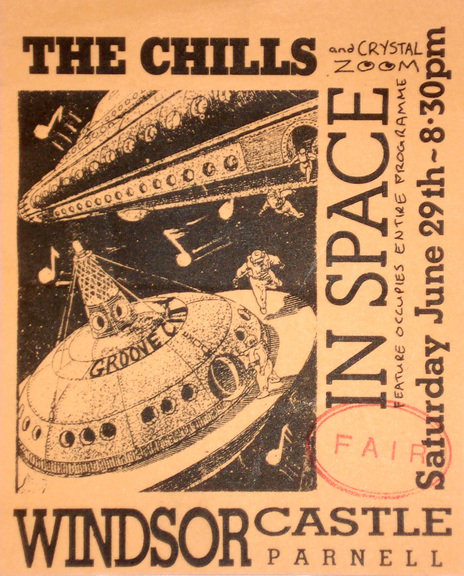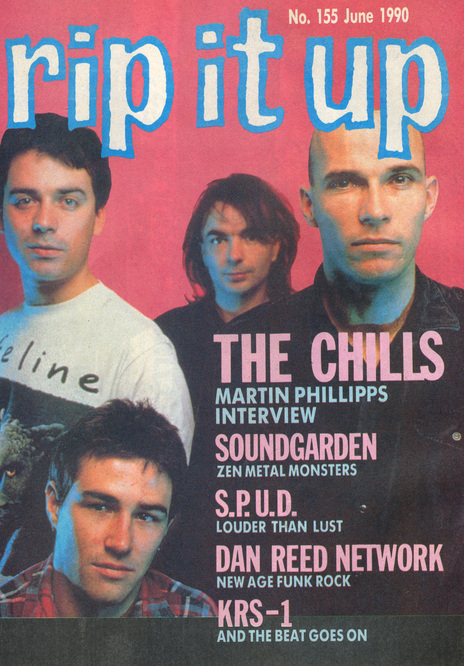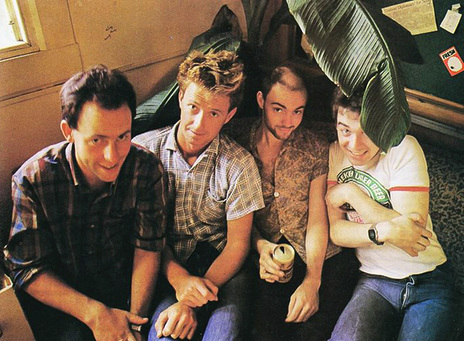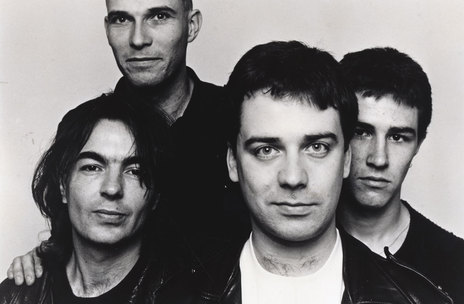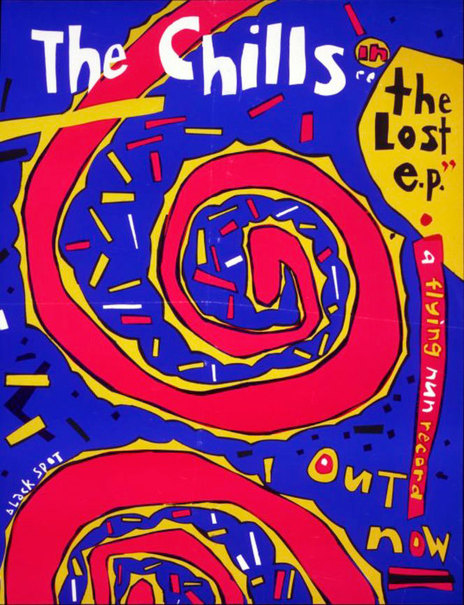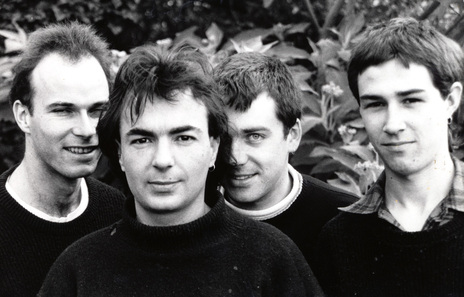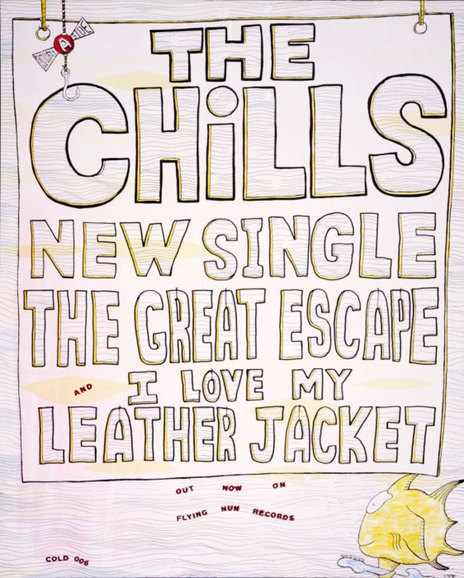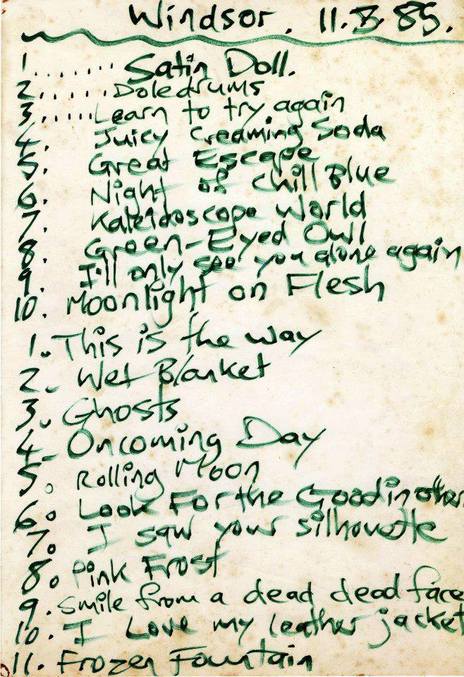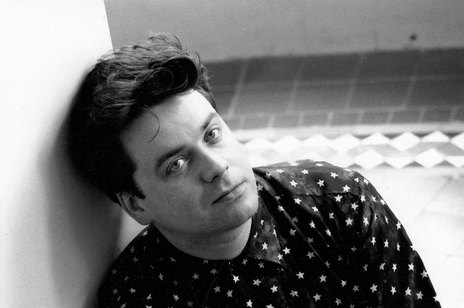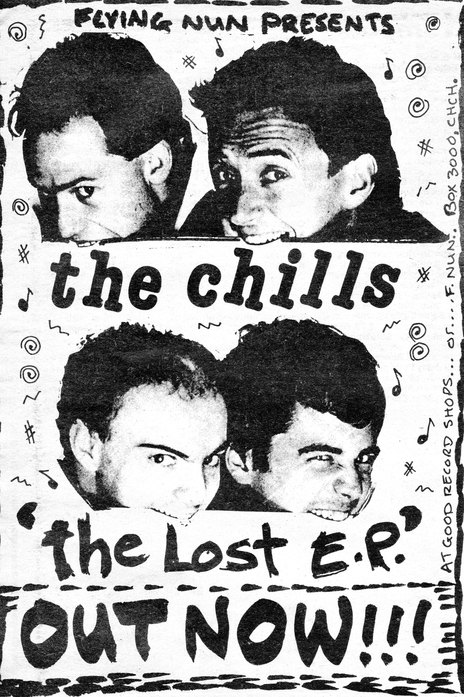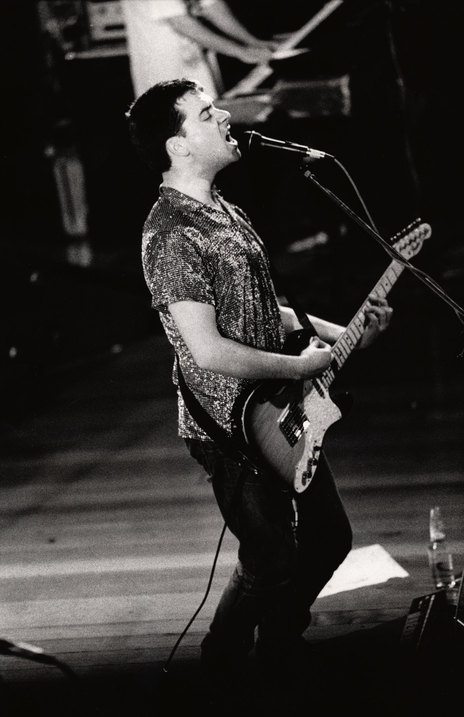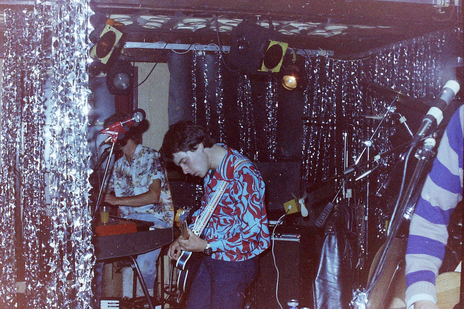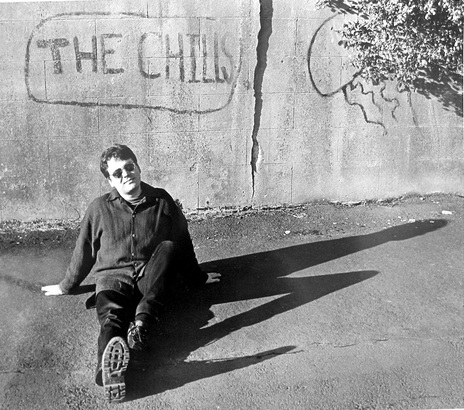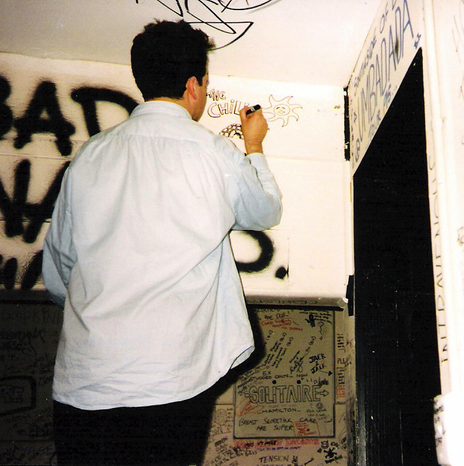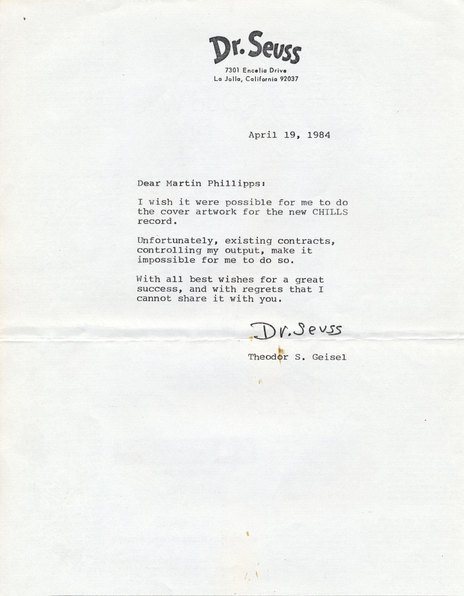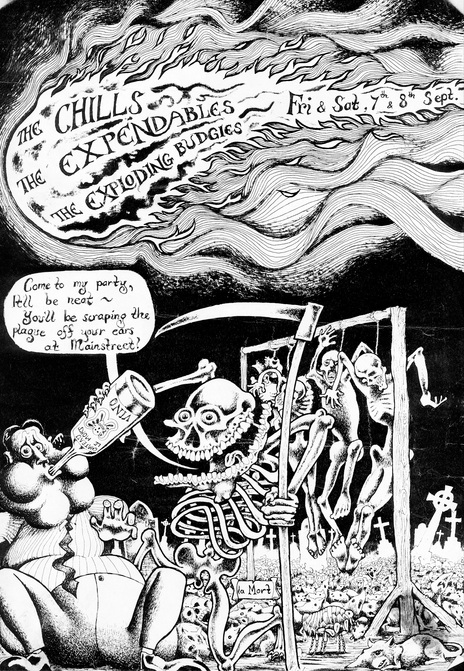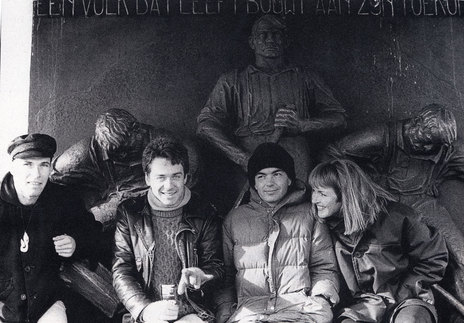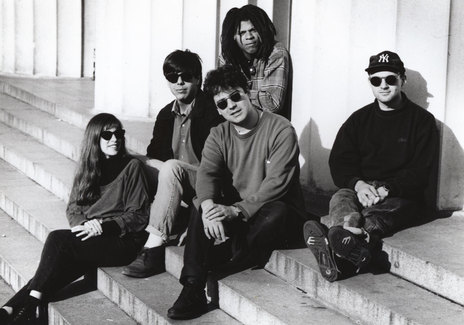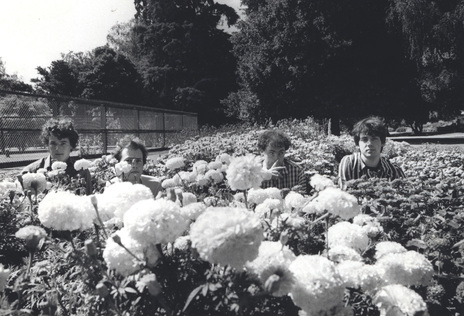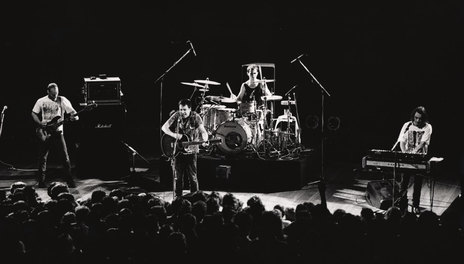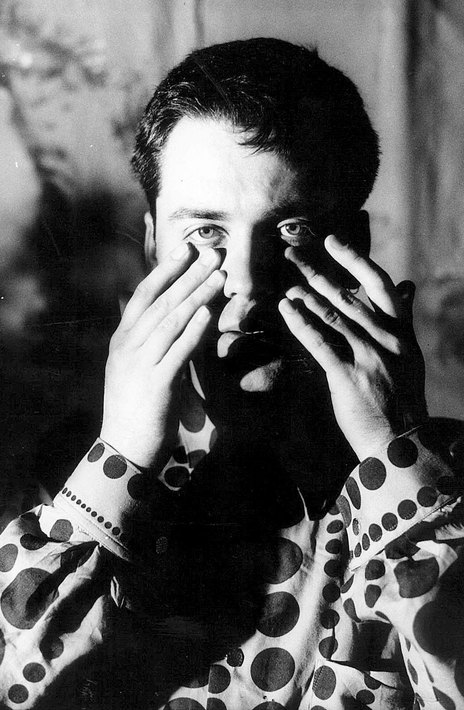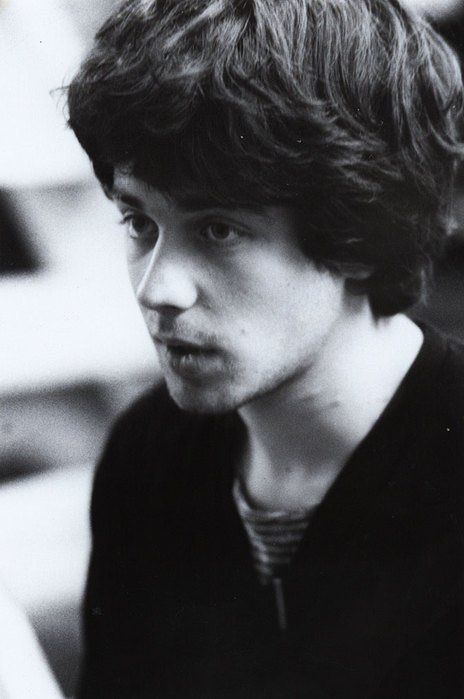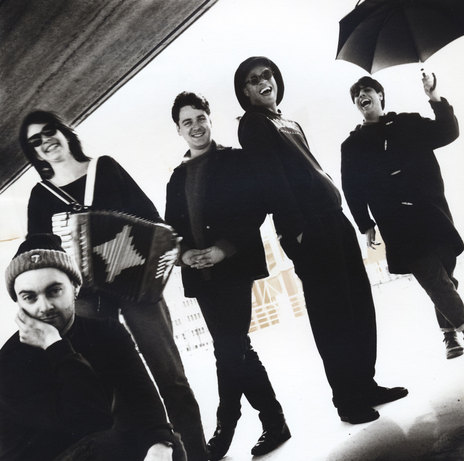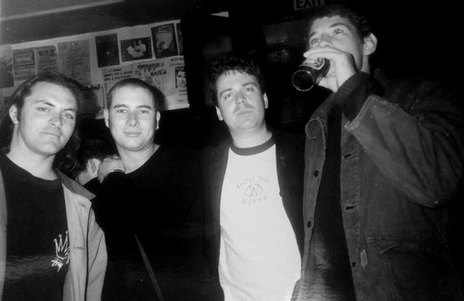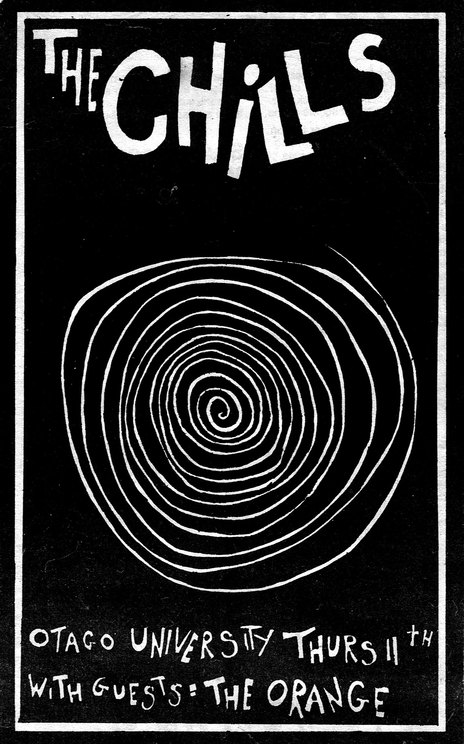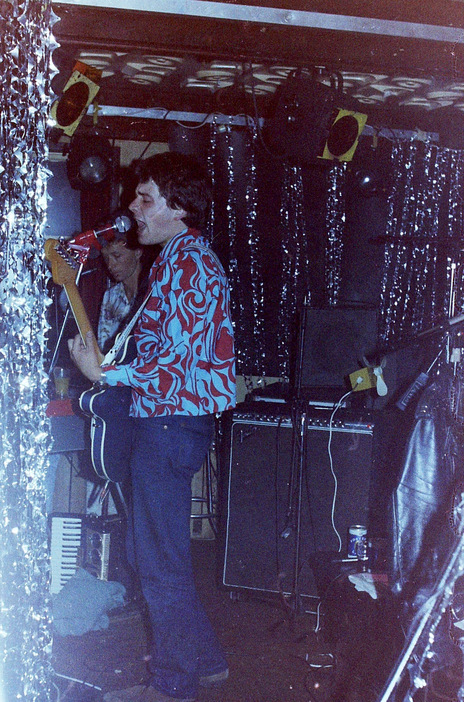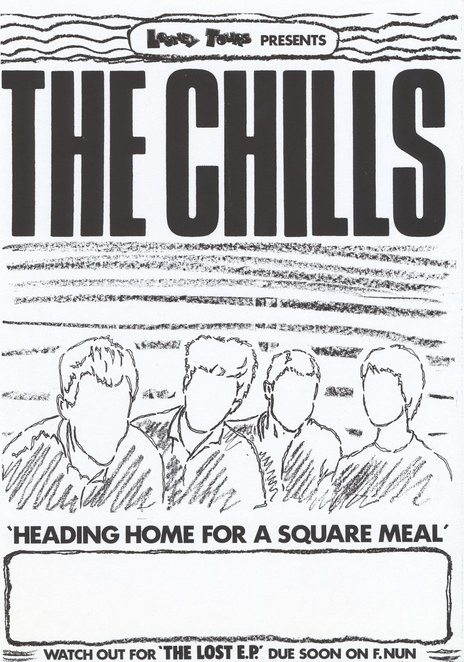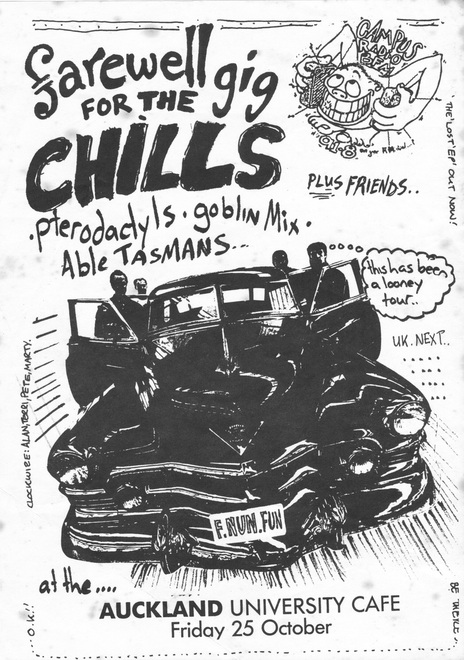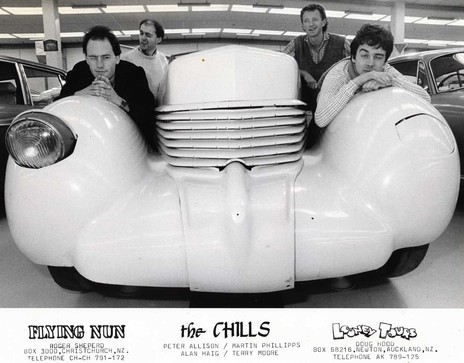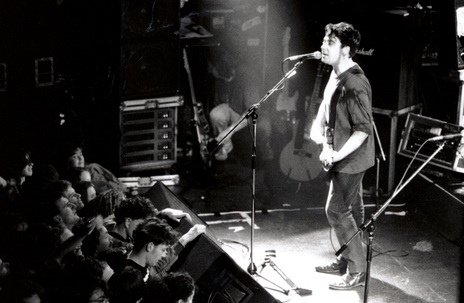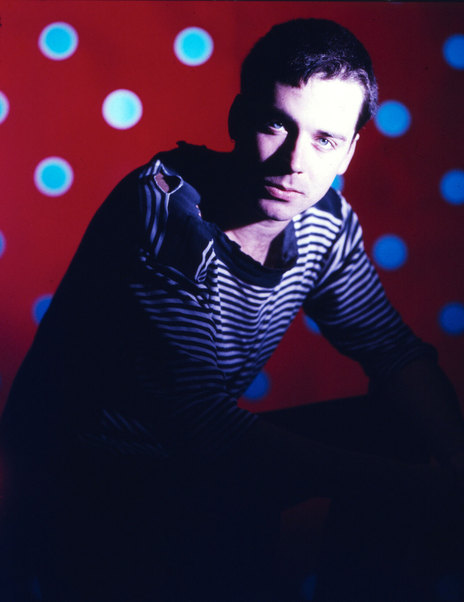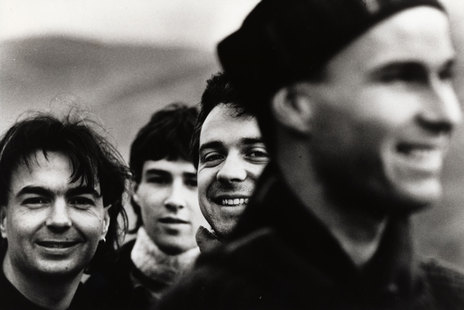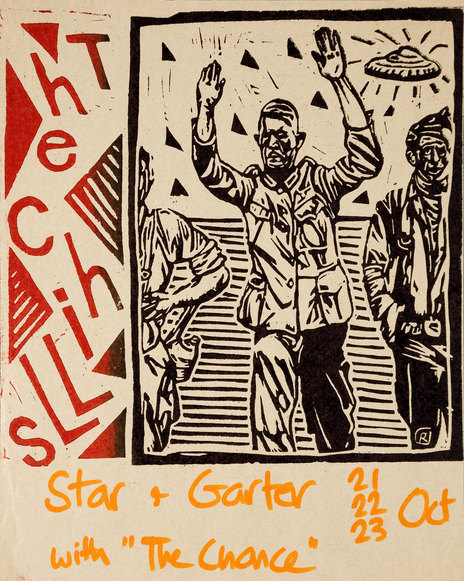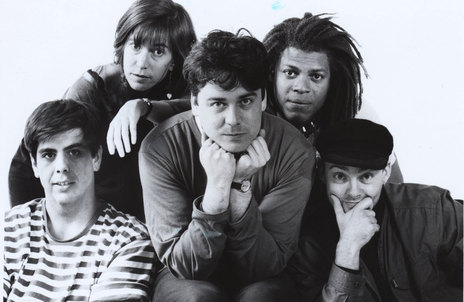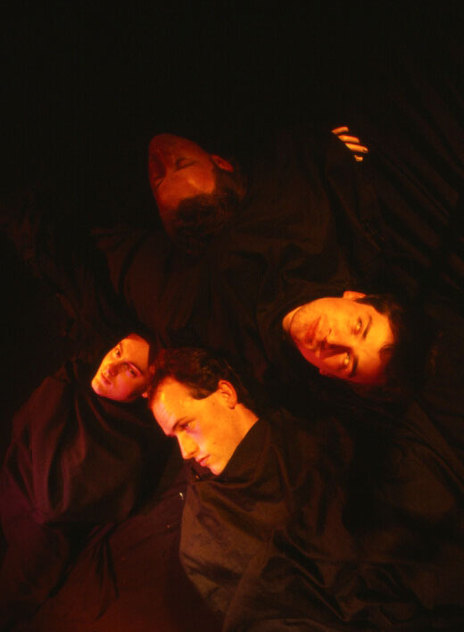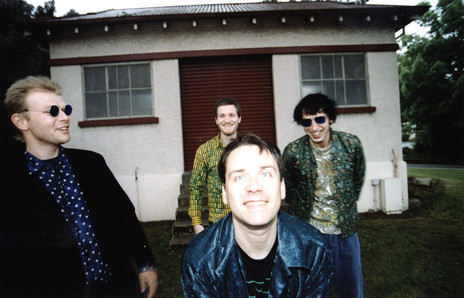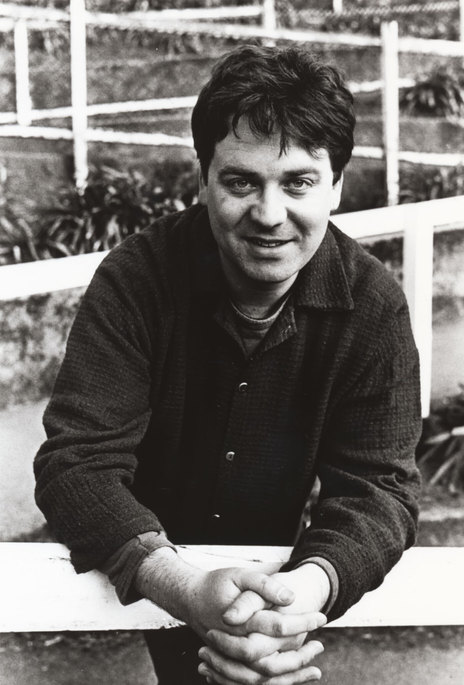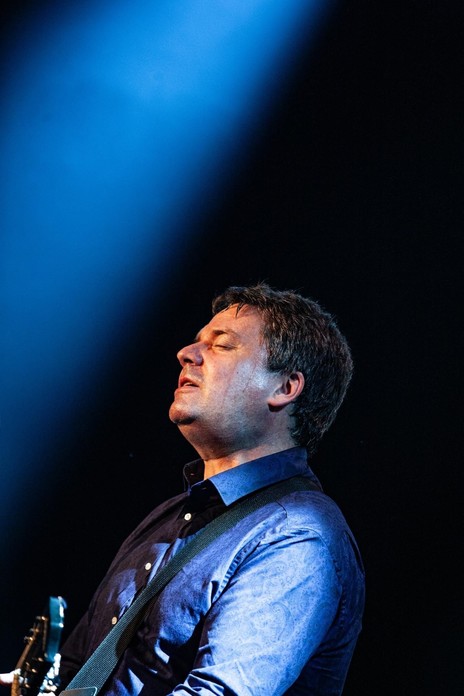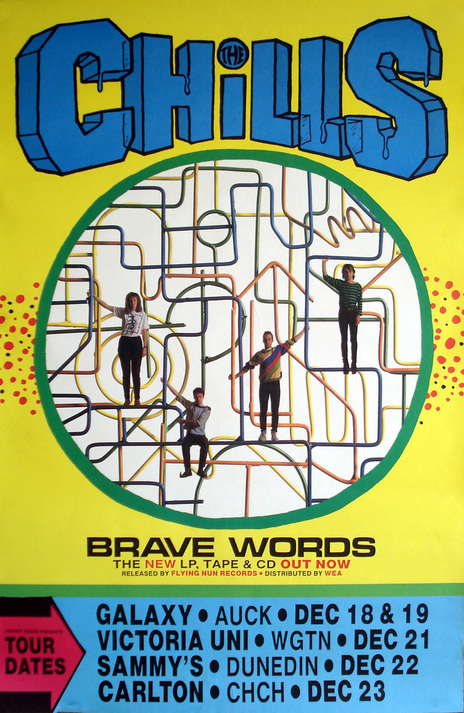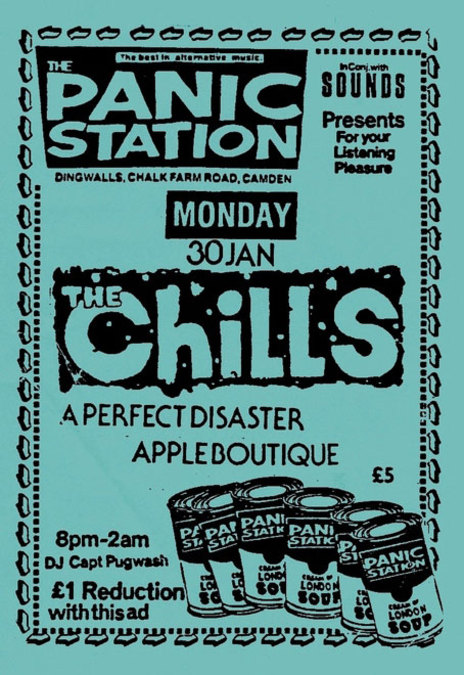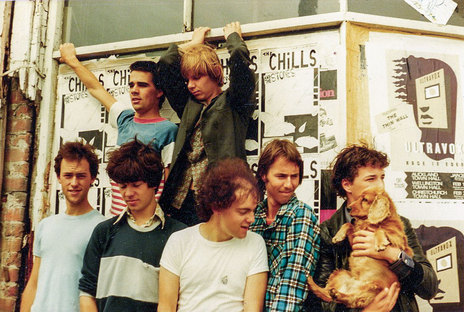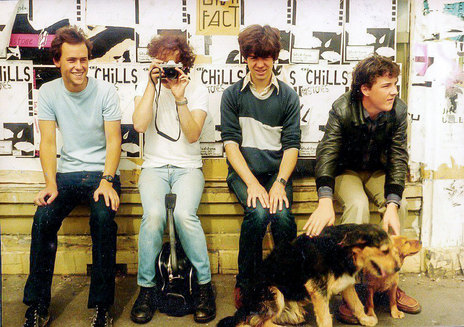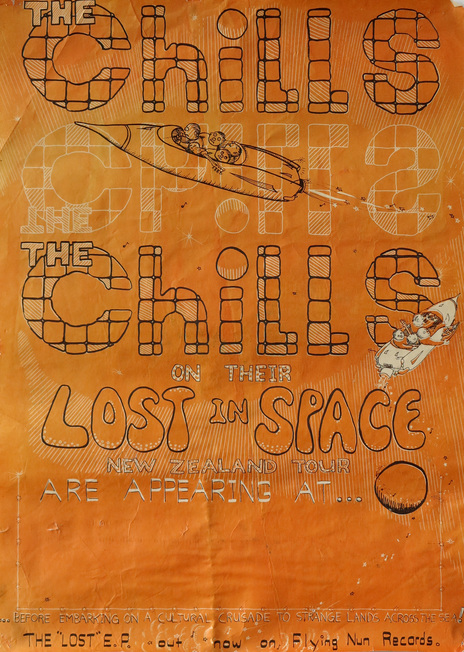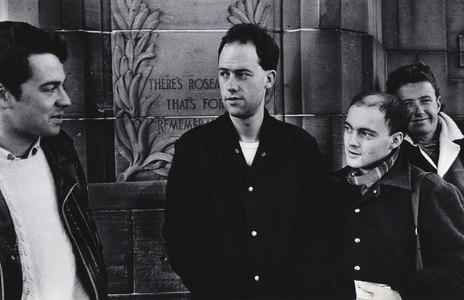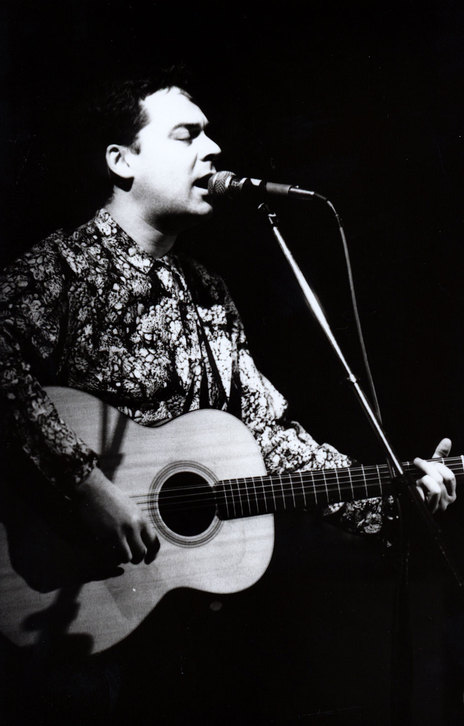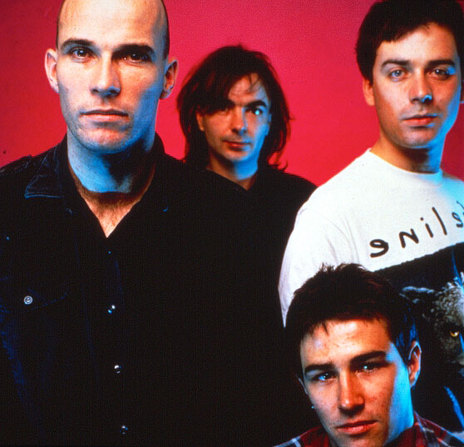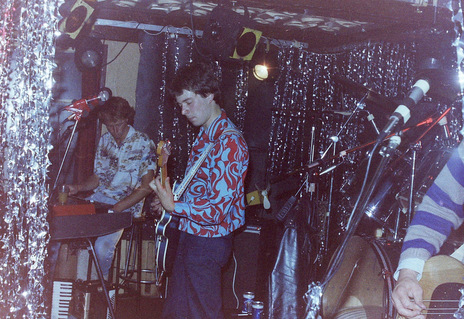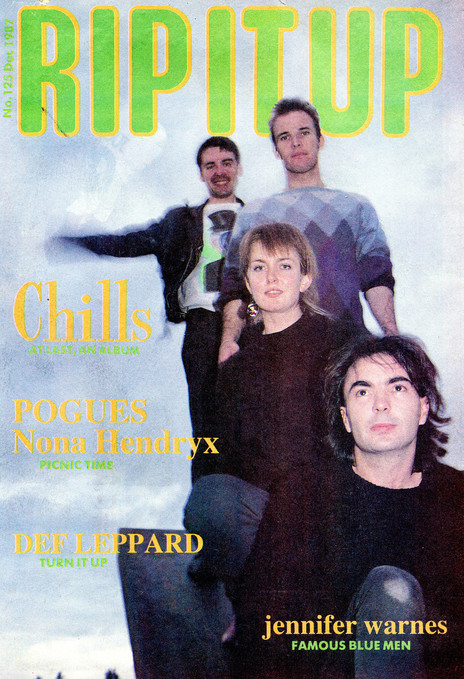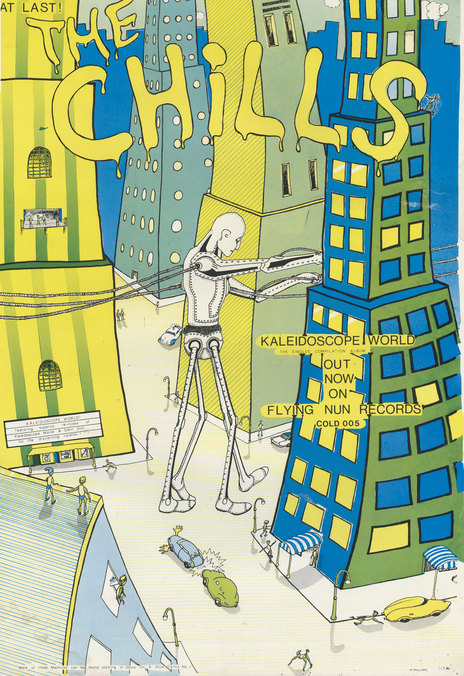Always popular at home, where all their albums and most of their singles charted, Phillipps found another gear out there in the wide world. He knew his sound would fit there as The Smiths and REM had showed him that. With the chart topping ‘Heavenly Pop Hit’ and Submarine Bells, an album with enduring intricacy and the classical pop smarts of The Beach Boys' Pet Sounds, he created music which garnered positive reviews everywhere it was heard.
The Chills entered the 1990s on the front foot, but something was amiss. Band grumbling began, line-up changes followed, and his next two albums were less focused as a result. His last hit single in 1996, ‘Come Home’, found Phillipps steadying himself by addressing the Kiwi Diaspora and his fading drive. His bulging songbook became an albatross and drug addiction and depression blighted his path in the late 1990s and the new millennium, allowing only flashes of genius since.
The Chills
Don’t let Martin Phillipps' modest demeanour fool you. He is The Chills, one of New Zealand’s most important pop groups of the 1980s and 1990s. He played all their shows, and wrote all but one of their songs. His desire fuelled many years of musical life and provoked one of the largest bodies of quality songs ever created by a New Zealand musician.
Yet for all the allusion and illusion at the heart of Phillipps' words and sound, he has always been a brutally honest, insightful and articulate appraiser of his own music and the world around it, often puncturing the myth that music writers and fans tried to build around him with soul-bearing truth.
Quickly outstripping their contemporaries, The Chills gained (and maintained) substantial success in New Zealand, before crisscrossing the western world to record Phillipps’ chill-blue songs for an ever-widening audience.
Throughout it all, he remained loyal to his place of creative origin – Dunedin – the lower South Island city where his father became Chaplain at Otago University in 1970. It's the place where he first found the pieces to his puzzle, plucked from the flowering of international pop culture in the second half of the twentieth century.
In that he was not alone. In the wake of punk and the possibilities it provoked, the city’s teenage population produced a strong crop of co-conspirators. In turn, they helped to spark Flying Nun Records, an indie label whose myth would outstrip The Chills and eventually subsume them amidst a pack of often inspiring, but less enduring talent.
Unlike the majority of his peers, Martin Phillipps got so close to the flame of mainstream success that it burnt him badly, while still failing to deliver anywhere near the level of success it had for his first hero, David Bowie. Instead, he returned home and retreated into himself, like his later inspirations Brian Wilson and Syd Barrett, resting on a cult-ish fame that is a constant reminder of what was and could have been.
Kaleidoscope World
The Martin Phillipps who left early Dunedin punks The Same in late 1980 was the not the same man-child who joined them. In that group, he was third fiddle to Jeff Batts (later of The Stones) and Craig Easton (early Verlaines) and a willing student to their teachings as he’d been to those of Toy Love’s Chris Knox and another 1960s survivor, second-hand record shop owner and journalist Roy Colbert.
Abandoning formal schooling early, he sought an alternative education amongst his peers – hitching north in 1979 in search of Peter Gutteridge (of The Clean) and Terry Moore (Bored Games) – the whole Kerouac on the road thing, he’d later describe it as. The following year, he was at Sweetwaters, New Zealand’s mass gathering of the music tribes near Ngāruawāhia, which opened his mind further.
“I was always into escapism, and a dreamer and would-be astronaut.” – Martin Phillipps
All the while, his musical palette widened as he took on board The 13th Floor Elevators, Television and garage punk (through The Clean’s Kilgour brothers), adding to the base glam sound he loved as an early teen. He was such a fan of David Bowie that he caught a rare Christchurch performance the night before his School Certificate science exam. Other influences included the fantasy fiction of Tolkien and C.S Lewis, Ray Bradbury sci-fi, and comics. “I was always into escapism, and a dreamer and would-be astronaut," he’d recall at the decade’s end.
In Dunedin, he took two songs from his Same days – ‘Kaleidoscope World’ and ‘Satin Doll’ – and formed The Chills with Peter Gutteridge, his sister Rachel, bassist Jane Dodd, and drummer Alan Haig. The almost casual melding of women into rock in an era of male dominance was typical of the quiet progressions Phillipps made. The Chills first show – up before The Clean at Beneficiaries Hall in November 1980 – exposed a brace of driven psychedelic pop.
As The Clean gained a strong following in New Zealand’s main centres, Phillipps’ group was often on the same bill – as in June 1981 at The Rumba Bar and Reverb Room in Auckland. When the Kilgour brothers’ trio recorded their chirpy surprise hit ‘Tally Ho!’ at Nightshift in Christchurch, Phillipps played the keyboard hook as he would often do live.
By then, it was clear he had an impressive collection of his own songs as Dunedin fans heard at hall and university shows and at the freshly opened new groups venue on the third floor of the Empire Tavern.
Christchurch – itself experiencing a surge of post-punk activity – warmed quickly to The Chills at The Gladstone in December 1981 and January 1982. They were back in the garden city in March 1982 for multiple shows at Canterbury University, the Star and Garter and Lincoln University, pausing long enough to record three songs – ‘Kaleidoscope World’, ‘Frantic Drift’ and ‘Satin Doll’ – for the Dunedin Double EP, which presented the first recordings of fellow Dunedin post-punk groups The Verlaines, Sneaky Feelings and The Stones. The pivotal record’s stark, playful, black and white sleeve did little to dim the 1960s pop-influenced musical colour spilling from within. Yet for all the promise that lay in the grooves, it was The Chills – Martin Phillipps, Alan Haig, new keyboard player Fraser Batts and bassist Terry Moore – who hit home hardest. An innocent, glassy-eyed video of ‘Kaleidoscope World’ showed them at play, blowing bubbles, and Phillipps, lost in space, resembling a shaggy-haired Syd Barrett.
Rolling Moon
The Chills were on the road again in May 1982 with The Clean, taking in Wellington, Auckland and Christchurch, before returning home to shows at The Cook, The Empire, Oriental Tavern, and all-ages venue The Pitz. Talking to Rip It Up in their first major interview, Phillipps outlined his inspiration: “Our music is the good bits taken from the last 20 years and most of it has come from outside of the popular. More the offbeat. I’m quite taken with The Cramps, The Velvet Underground and Syd Barrett is one of my favourite people. I started off listening to glitter music and then new wave, missing out all the stuff before that. With New Wave you get an attitude, where it’s difficult to listen to anything else and it takes a long time to break out of that.”
With new drummer Martyn Bull, and Rachel Phillipps on keyboards, The Chills taped ‘Rolling Moon’.
With new drummer Martyn Bull, and Rachel Phillipps depping on keyboards, The Chills taped ‘Rolling Moon’, ‘Bite’ and ‘Flamethrower' (live) in Auckland on Toy Love stalwarts’ Chris Knox and Doug Hood’s 4-track. Housed in a Martin Phillipps-designed superhero cartoon sleeve, the sunny, summery, upbeat ‘Rolling Moon’ was the perfect first single. The record buying public certainly thought so, pushing it No.26 in the charts in December, 1982. Flipping it over, you got two compelling tracks in ‘Bite’, a raging slice of pop-punk, and ‘Flamethrower’, where Phillipps et al let rip with dirty Modern Lovers guitar overload abandon.
December 1982 would be an early high water mark for the group. Their proposed next single, the wide-eyed pop-punk of ‘Oncoming Day’ was already recorded and a video taped for Radio With Pictures. A live version featured on 'Friends Of The Enemy', a 1982 Dunedin scene overview directed by Simon Morris for RWP in which Phillipps also has his say. ‘Oncoming Day’ like its predecessor, ‘Rolling Moon’, was inspired by the young Phillipps' encounters with pot and love and the magical city and its environs. The first tapings of eventual followup single ‘Pink Frost’ had also been made and they captured ‘Dolphins’ on film for teen music show Shazam. All of which was reported, along with another list of musical influences and references to classic English gothic architecture, by Roy Colbert in the NZ Listener’s Soundcheck column.
Pink Frost
If ‘Kaleidoscope World’ was spring, and, ‘Rolling Moon’ summer, winter came early for The Chills when Martyn Bull began showing signs of leukaemia. It was a testing few years as Bull’s health ebbed and improved. There were no Chills shows at all between October 1982 and early 1984 with Phillipps' only live appearances being at The Empire Tavern with The Clean’s David Kilgour as a duo, and with tentative new group, A Wrinkle In Time. As he often did when times were troubled, Phillipps stayed near to home and the familiar. Describing The Empire Tavern in Garage fanzine in 1986, Phillipps paints it as being: “Just like a modern folk club … It was warm and friendly and the Dunedin winter would be howling outside, lashing at the windows and people were singing along to stuff like The Clean’s ‘Odditty’, which is what folk music is about. Just a solid core of good feeling between the crowd and the bands.”
Martyn Bull passed away in Masterton on July 18, 1983, aged 22, just months after marrying, with Phillipps as his best man.
Despite the cold snap his untimely death sent through the close-knit Dunedin scene, it wasn’t enough to stop The Chills reconstituting (as Bull had wished) with Alan Haig joining Phillipps and Moore and new keyboard player Peter Allison, in late February for the nationwide Looney Tour – Flying Nun’s first package show – with Children’s Hour (from Auckland), Doublehappys and The Expendables.
‘Pink Frost’ would peak at No.17 in June 1984, staying a staggering 18 weeks in the pop chart.
In Auckland, the group put the final touches to ‘Pink Frost’, their fine second single, which would peak at No.17 in June 1984, staying a staggering 18 weeks in the pop chart. ‘Pink Frost’ had a subdued tension and hummed along on a swish Terry Moore bass line, which underpinned a fine melancholic pop surface. The video reflected that mood with Martin Phillipps walking through a pine forest above storm-stung cliffs on the Otago peninsula.
Looney Tours
‘Pink Frost’ was a fine way to begin The Chills' second chapter. They went full-time in late 1984, touring solidly that year and into 1985 in their own right. They also supported Split Enz on the South Island leg of their farewell Enz with a Bang tour, and opened for Lou Reed in Auckland in January, 1985, gathering up the beginnings of what would be an enduring and truly popular following.
Phillipps later put it down to: “I feel very fortunate that … my bands have often crossed those typical boundaries between the more elite and knowledgeable music lovers, and the casual, maybe more working-class people who can still respond to some truth they hear in my music.”
Their third single ‘Doledrums’ lived up to its name. It was a creative mis-step, flagged by an uninspiring video. Even so, it climbed to No.12 in December 1984, further evidence of The Chills strong live following. Record industry recognition also came their way for the first time that year, but still no radio airplay outside student radio.
With New Zealand in their pocket, the sub-Antarctic popsters eyed up England, where ‘Pink Frost’ was gaining good reviews in the music papers. Supporting The Go-Betweens at Auckland’s Gluepot in mid-February, 1985, they picked the Australians’ minds on their overseas experience, coming away with a desire to tour Great Britain, but not live there.
Already resident in Auckland, The Chills put their songs together for 'The Chills In Space', a sci-fi themed bFM radio special and live show at the Windsor Castle in late June 1985. The long-in-gestation The Lost EP was also finally finished. A fractured affair, it contained two highpoints – ‘This Is The Way’ and ‘Dream by Dream’ – and climbed to No.4 in August 1985, staying in the charts for 17 weeks.
When new member Martin Kean dropped out of the group, Terry Moore re-joined. The Chills then pushed their proposed departure date for England to November in order to write new songs and toured hard to earn the $25,000 needed to survive. There was no government support for overseas pop music forays in the 1980s. One last whistle-stop tour in October and they were gone – destination London, where The Lost EP was getting good reviews.
The Great Escape
England the first time was a buzz. You can tell by the music The Chills produced there and the video and documentary they sent back to New Zealand. Funning it on the streets of London, gliding down escalators to their next hit single ‘The Great Escape’. All leather, attitude, mirrored shades, brick walls and stomping glam guitars on ‘I Love My Leather Jacket’, the single’s top side.
‘The Great Escape’, with its spooky, descending riff had been taped live at Auckland's Windsor Castle on October 12, 1985, and ‘I Love My Leather Jacket’ was recorded at Point Studios in London in December just before The Chills returned home, although it wasn't released until late 1986. When the impressive double-sider charted in January 1987, it rose to No.4 and re-established the group in New Zealand.
an early career gathering compilation, Kaleidoscope World, hit the British indie Top 10.
In London, The Chills put together an early career gathering compilation, Kaleidoscope World, for hip indie Creation Records, which hit the British indie Top 10 in March 1986 on the back of rave reviews, rising to No.3 in April. The collection also showed Dunedin groups had pre-empted the emergence of a similar sound in England and Scotland by at least three years.
Their first session for influential Radio One DJ John Peel was taped in November, 1985, during a string of London shows.
Press notices for The Chills’ visit were mostly positive, aided by the support of New Zealander David Swift, an NME staffer and former drummer for Flying Nun act Mainly Spaniards, who penned the first feature on the label for his new employer and would continue to push his countrymen, although some doubts lingered in the wider music press about uneven Chills live performances.
The Chills flew back to New Zealand in December, determined to return and build on the profile raising they’d done. When they did it would be without Alan Haig and Peter Allison, who’d had enough.
At home, fan and media interest remained high, buoyed by the New Zealand Herald joining Rip It Up as champions of the group. Reflecting on their maiden journey, Martin Phillipps talked of images and scenes and cults and not having one of their own. He also noted Rough Trade Records had agreed to distribute releases from Flying Nun Records in the UK and uttered “the curse of The Chills” in response to having to form yet another line-up. Then Terry Moore decided to leave as well.
The group that Phillipps formed to replace them was his most enduring. Wellingtonian Caroline Easther was the new drummer. Aucklanders Justin Harwood (bass) and Andrew Todd (keyboards) filled out the line-up. The lack of Dunedin-ites caused some discomfort amongst New Zealand indie fans who thought the pool of Southern talent was bottomless.
The new Chills were playing out again by June 1986, helping to push Kaleidoscope World into the New Zealand Top 20 in August. Their first full national tour – the Hello Goodbye tour – began in January 1987, just before they made the jump again to London, where ‘I Love My Leather Jacket’ was released in March on the new Flying Nun Records (UK) label run by Chills manager Craig Taylor. The Chills were in Europe, well into their longest series of shows by then.
House With a Hundred Rooms
Between February and December 1987, The Chills were on the road constantly. Their itinerary looked something like this: Belgium, Holland, Sweden, West Germany, Norway, England, Greece, New York, back to Holland, Scotland, England, West Germany, Austria, Switzerland, Italy, Belgium, Holland, West Germany and England. Join a band and see the (old) world.
They took time out to record their first new album Brave Words with Red Crayola kingpin Mayo Thompson, a Rough Trade Records connection, in June and July 1987 at London’s Point studios. Paid for by Flying Nun Records and their German distributor Normal Records (soon to become Flying Nun Europe), it cost $30,000.
‘House With A Hundred Rooms’, their Great Britain and Europe-only single – a British indie chart hit in August 1987 and their best released song since ‘Pink Frost’, which it resembled in feel – had already been captured in May. The Chills' second Peel session, with ‘Living In The Jungle’, ‘Rain’, ‘Dan Destiny and The Silver Dawn’ and ‘Moonlight On Flesh’ was taped in June. The same month, The Chills performed before tens of thousands at the Glastonbury festival in England.
Media interest in Great Britain and New Zealand was high with The Chills making the front cover of Rip It Up in April 1987, which ran a two-part on the road piece, and the New Zealand Herald ran copy from London-based journalists. Former Radio With Pictures producer Brent Hansen, then working for MTV, also filmed the first feature on The Chills.
Talking to the New Zealand Herald about the album, Phillipps indicated an important shift in his thinking: “Contrary to the popular beliefs of the New Zealand underground that energy can’t be captured using high quality production, we’re going to show them it doesn’t end up soulless.”
In discussion with Rip It Up, he referred to the drum machine used on new song ‘Dark Carnival’. He also talks of using samples when they’re right for his songs and technology to improve The Chills' live sound, although the progress made Phillipps nervous about how fans would react. Just as well then, that a new door was about to open for his group.
The Chills hopped the Atlantic in August for the New Music Seminar, a yearly event prompted by the rising force of college radio and an underground music community poised to go mainstream. The Chills’ showcase gigs in New York (at historic folk club The Bitter End), New Jersey, Boston and Washington D.C. were well received, buoying Phillipps for the next phase in his career, which would see Kaleidoscope World and Brave Words released in America in 1988, supported by a continent-wide tour.
Brave Words
With the future still bright and alluring, The Chills returned home in late December 1987 for a January to February national tour promoting the newly released Brave Words.
Housed in a Martin Phillipps-designed cover depicting the band in an Airfix-like model grid, the album climbed quickly to No.26 on the charts, but stayed only four weeks in total – a surprisingly muted reception for what is a strong collection of songs. Side two has a classic run of Chills tracks from ‘Dan Destiny and the Silver Dawn’ through ‘Night of Chill Blue’ (about the night skies in the Marlborough Hills), ‘16 Heart Throbs’, ‘Brave Words’, ‘Dark Carnival’ (about recently deceased friend Mark Edwards) to ‘Creep', and the flip side showed Phillipps’ songbook was far from depleted. ‘Wet Blanket’, the single plucked from the album, failed to chart.
When ‘Brave Words’ came out in the Us, veteran critic Robert Christgau awarded it an A-.
Again, reviews were mostly positive with the New Zealand Herald awarding Brave Words five stars out of five. Melody Maker name-dropped Julian Cope, Syd Barrett, The Buzzcocks and The Velvet Underground’s ‘Sister Ray’ while describing “an album of half-light, cloud and half-clutched chimeras of hope.” Jack Barron in NME – under a "Cool Dudes" headline – called Brave Words a dark carnival and raved about “two of the most spectral unrequited love songs of the decade” in ‘Wet Blanket’ and ‘Night Of Chill Blue’. When Brave Words was released in the United States through Homestead Records, veteran music critic Robert Christgau awarded it an A-.
On home turf, The Chills, with barely a moment to pause, geared up for the aborted Neon Picnic, a failed summer festival that was planned to be held just outside Auckland, then played a free show with other acts in West Auckland. Sydney and Melbourne beckoned in February and a New Zealand national tour in April and May, during which the group’s van collided head-on with an oncoming truck. The crash could have been fatal, but miraculously only manager Doug Hood was injured.
Caroline Easther left the group in Christchurch early May 1988, citing hearing difficulties. A major loss for the band, her drumming and temperament would be missed. She was replaced by James Stephenson, a teenage Auckland punk. The group eased him in with shows in Auckland in September before striking out for Australia and an extensive trawl through the United States and Canada, ending at CBGBs in New York, then on to Scotland and England in November 1988. It was a journey they nearly didn’t make after Martin Phillipps was busted with marijuana in his bag in a Hamilton tavern carpark. A group friend had been smoking up in the tour van when the police tapped on the window. A subsequent search turned up Phillipps’ small stash, which The Chills’ main man readily admitted to. Entry into America is almost impossible for anyone with a drug conviction. Luckily, then, a rare discharge without conviction was granted, to the relief of the band and its followers.
Heavenly pop hits
The Chills belonged to the world now. They toured Europe in February 1989, then signed to Slash Records in June 1989 for seven albums after the Los Angeles indie headed off a number of interested mainstream record companies. Distribution, promotion and tour support would be provided on an album by album basis by Warner Bros. in America, London Records in Europe and Liberation Records in Australia. Flying Nun Records retained New Zealand rights, a generous, but not untypical concession to his roots from Phillipps.
Submarine Bells, The Chills’ first major label release, was recorded with producer Gary Smith at Jacob’s Studios in Surrey, England, over eight weeks between August and October 1989. New songs abounded on the concise 32-minute collection, including four about Phillipps’ ex-girlfriend. Then it was straight back onto the live circuit in England and France, and home for a welcome break to write songs.
‘Melody Maker’ made ‘Heavenly Pop Hit’ single of the week and called its parent album “a magical experience”.
When Submarine Bells and lead single ‘Heavenly Pop Hit’ were released in March, 1990, in the middle of The Chills' next British tour, they attracted rave reviews from the British music press. Melody Maker made ‘Heavenly Pop Hit’ single of the week and called its parent album “a magical experience”. NME gave Submarine Bells eight out of ten, and described it as more “mature and complex – a complete album.” The reaction in America was also positive. ‘Heavenly Pop Hit’ spent seven weeks on Billboard’s Modern Rock Chart and Submarine Bells wrung yet another endorsement out of Robert Christgau.
In Athens, Georgia, in mid-April at the beginning of a three-month USA tour, The Chills took the stage at REM’s 40 Watt Club. Afterwards, lead singer Michael Stipe showed Martin Phillipps around the state. A nice gesture from the then-breaking American indie guitar act, in whose wake The Chills had signed. The groups had much in common musically, having emerged after punk in decentralised independent music scenes, which had slowly knitted themselves together in the late 1980s and early 1990s, before emerging into the mainstream.
When the masterful, almost stately Submarine Bells was released in New Zealand in June 1990, it jumped to No.1 in the New Zealand charts, one place higher than ‘Heavenly Pop Hit’, which peaked at No.2 in the singles chart. With the Flying Nun Records coffers filled by Mushroom Records, the label was finally able to provide the push The Chills needed. Phillipps and his group toured Australia in June and New Zealand in June and July, but with the group close to exhaustion, a proposed American tour in the second half of 1990 in support of Submarine Bells and new radio single ‘The Oncoming Day’ was cancelled. New Zealand dates, thereafter, were thin.
In late 1990, The Chills finally won over the New Zealand music industry, who voted them Best Group, Album of the Year and Single of The Year, and Phillipps, Songwriter of the Year. A bittersweet acknowledgement. Justin Harwood and Andrew Todd had left the group in July, citing communication difficulties with Phillipps. They were also unhappy just interpreting Martin’s ideas. He’d tried creative democracy, Phillipps later explained, but it led to generic music. Whatever the reason, the loss was debilitating. They’d been a tight unit who made inspiring records and left enduring memories of live performances that are still vividly recalled today.
Soft Bomb
The wonder is Martin Phillipps didn’t call an end right there. He was tired of the endless touring, the lack of time to write in his beloved city, Dunedin, and the endless line-up changes. On the upside, The Chills’ record companies Slash, Warner Bros. and Flying Nun/Mushroom still had faith and Phillipps began demo-ing songs for his next album, to be called Soft Bomb.
The Chills’ record companies Slash, Warner Bros. and Flying Nun/Mushroom still had faith.
A new Chills wasn’t long in coming. James Stephenson stayed, Terry Moore rejoined and Gillian Dempster from Dunedin played keyboards. Moore’s addition, in particular, pleased older New Zealand fans who credited the bass player as one of The Chills’ best. Phillipps initially agreed with them, but soon changed his mind. Talking to NZ Musician in 2008, he remembered: “This time the magic wasn’t there. I guess he’d moved on to some of the newer, more exciting developments in music and I was still trying to do what I felt was natural to me. Subsequently I didn’t have my most crucial ally with me when I realised that no-one else understood the punk power that was meant, as always, to drive these ‘pop’ melodies.” The new line-up crossed the Tasman in January and February 1991 for their first extensive tour of the great southern land, but didn’t last.
When Phillipps left for Los Angeles’ Master Control studios in late 1991 to record Soft Bomb, Terry Moore was the only member retained. To flesh out his ideas and sound, Phillipps and producer Grant McKillop drafted in session musicians, including REM offsider (and ex-Fleshtone) Peter Holsapple, and arranger Van Dyke Parks, who’d collaborated with Brian Wilson on his long-unreleased 1960s masterwork Smile. Knowing that, Soft Bomb’s ambitious sound and structure wasn’t especially surprising.
The recording sessions were not without tension. “The main problem was that he (McKillop) couldn’t hear the potential force in songs like ‘Double Summer’ and ‘Ocean Ocean’, which I had seen as awesome singles. Gavin would have chosen to leave them off in favour of the darker material, which caught his fancy,” Phillipps later reflected.
“This left us with a song like ‘The Male Monster From The Id’ as a lead single and I knew that would never get us anywhere – let alone with its dark eyeball and scissors video. Warner Bros. heard of the confrontation and nearly scrapped the project midway, except I persuaded them '… we are getting on much better now, thank you!'”
Soft Bomb featured a string of classic Phillipps songs – ‘So Long’, ‘Song For Randy Newman’, ‘Sleeping Giants’, ‘Double Summer’ and ‘Sanctuary’ – buried at the end of side one and the beginning of side two, and was released simultaneously in the United States and Australasia in June 1992. Support for The Chills was clearly still strong in New Zealand, where Soft Bomb peaked at No.3 in June 1992, and lead single, ‘Male Monster From The Id’, No.7.
With Terry Moore remaining on bass, Phillipps cast his net outside New Zealand for the first time, adding American musicians Steve Schayer (guitar), Earl Robertson (drums) and Lisa Mednick (keyboards) to his touring group. Mednick and Schayer both featured on the album. This line-up toured New Zealand and Australia from July to September, before Robertson was replaced.
New drummer and old Flying Nun hand Craig Mason came on board for America and Europe. They were midway through the second leg of the tour when Phillipps learned Warner Bros. had pulled their tour and promotional support after weak album sales. This, despite laudatory reviews from the likes of Robert Christgau who called Soft Bomb “evanescent”.
“As with so many formal coups,” Christgau opined, “One of the pleasures of Submarine Bells was how incorrigibly it challenged unwritten rules (about brightness, concreteness, pretension, keyboards) while adhering to the ones you really can't break (about tunefulness, concision, savvy, guitars). This is just the opposite: adventurous on a surface that accommodates depressive codas and Van Dyke Parks strings … Even when they're all 20 seconds too long, Phillipps’s tunes stay with you.” He also suggested dropping the Soft Bomb song fragments and re-sequencing the album.
Unable to continue on to Europe, one of their strongest markets, The Chills returned to New Zealand. The corporate phase of their career was now over. A rupture attributed by Phillipps to the rise of grunge music, post-Nirvana.
Sunburnt
Deep in debt, Phillipps disbanded The Chills and went home to Dunedin. Always melancholic, he began to slide into depression, although there was some early light. He’d embraced his garage punk and folk punk roots with The Pop Art Toasters – a band of Dunedin greats who released a vibrant CD EP of covers in 1994, and The Chills greatest hits compilation Heavenly Pop Hits returned him to the New Zealand charts in December that year.
Buoyed by this and Flying Nun Records continuing support, he assembled a new Chills with New Zealand musicians Dominic Blaazer (keyboards), Steven Shaw (bass) and Jonathan Armstrong (drums) in advance of one final crack at America, Great Britain and Europe. Martin Phillipps and The Chills – as they were to be known – upped their profile in 1995 and 96, appearing onstage at the second Big Day Out in Auckland in January 1996.
Phillipps then set about constructing Sunburnt, his third album of the 1990s, recording some strong demos with his touring group, including ‘Streets of Forgotten Cool’ and ‘Yabba Dabba Do’, which would appear as B-sides. The album proper was laid down with producer Craig Leon at Doghouse Studios in Henley-On-Thames, Oxfordshire, England, in August and September 1995. Like its predecessor, it featured Phillipps and session musicians, only this time it wasn’t by choice. Armstrong and Shaw had been turned back by British customs. Their replacements were Dave Gregory (XTC) and Dave Mattacks (Fairport Convention).
‘Sunburnt’
featured Phillipps and session musicians, only this time it wasn’t by choice.
A New Zealand tour in March and April 1996 heralded the new album, but failed to push the patchy work higher than No.25, eight places above ‘Come Home’, his reflective final hit single in February. Overseas again in October and November, The Chills said farewell to their American, British and European fans, bowing out at the famous Troubadour club in Los Angeles on November 15, 1996. The group, who in Phillipps’ words had been “the ‘I Love My Leather Jacket’ band in Europe; the ‘Pink Frost’ band in England and the ‘Heavenly Pop Hit’ band in the United States,” returned home for good.
Sketchbook
Faced with what might have been and carrying years of tension and worry alongside unalloyed joy, it’s not surprising that Martin Phillipps slipped further into clinical depression and sought relief in heavy drugs, contracting Hepatitis C. What is surprising is the honest and candid way he revealed those dark days. As he did in March 2005 to the NZ Herald’s Canvas magazine, who found Phillipps, finally free of the virus after Interferon/Riboviron treatment, amidst an immaculately arranged collection of records, books, movies and toys in his Dunedin home. They’d caught him on an up day, clearly, where the future promised much. A relief for his many New Zealand fans. It had been a quiet eight years since Sunburnt.
Quiet, but not barren. They’d been regular, if sparse performances (mostly in the South Island), an album of demos called Sketchbook in 1999, and better still, the four-CD Secret Box (2001), which brought together many unreleased Phillipps recordings and rare tracks. He also performed in 2001 at the opening of Jurassic Park III in Dunedin Town Hall. May 2003 found The Chills touring the country with Blam Blam Blam and The Newmatics on the True Colours tour.
In 2004, he released the first Chills record since 2001 – the Stand By CD EP, one of his best collections – and toured New Zealand with a group, whose core of James Dickson (keyboards), drummer Todd Knudson and bassist Rodney Haworth had been with him since late 1999 when they supported Split Enz on New Year’s Eve.
Mostly though, he’d been quiet, living under the radar in Dunedin and playing the occasional show. In September 2008 in an echo of the late life respect shown to his heroes’ Arthur Lee and Brian Wilson, a glowing Martin Phillipps performed ‘Heavenly Pop Hit’ with an orchestra and choir at the APRA Silver Scrolls in Auckland. A truly beautiful moment. He followed that with his first trip overseas in years to play shows in Sydney and Melbourne in November. The following year, he recorded Tall Dwarfs’ ‘Luck Or Loveliness’ for his old mentor, Chris Knox, who’d recently suffered a stroke. More recently there’s been new talk of a new album.
Molten Gold
Martin Phillipps and The Chills kicked off a new phase in their long and productive history in 2013 by signing to British label Fire Records. The first release in the new deal was ‘Molten Gold’, a swirling Celtic gem of a pop tune that appeared for Martin Phillipps’ 50th birthday in July 2013.
Surprisingly (given punk’s abhorrence of that particular extended form), a triple live LP, Somewhere Beautful was captured at a private party in Central Otago on New Year’s Eve 2011. The new record was in shops by October 2013. Well-known New Zealand artist Shane Cotton provided the art that came with each album.
After South Island shows in 2013, live outings followed for The Chills in Auckland, Christchurch and Dunedin in 2014.
In June 2014 the first new collection of Martin Phillipps’ originals since Sunburnt in 1996, was recorded at Albany Street Studios in Dunedin by Brendan Davies. By mid-July, Phillipps and The Chills (Erica Scally, Oli Wilson, Todd Knudson and James Dickson) were in England for the Dunedin quintet’s first northern hemisphere tour in 18 years.
A very real buzz and expectation filled the air. A four-song session and interview with former Fall musician Marc Riley on BBC6 debuted a new instrumental, ‘Underwater Wasteland,’ and featured the reappearance of ‘Pink Frost’ with new extended intro.
Talking to Riley about The Fall’s New Zealand tour in August 1982, Phillipps and the presenter argued good-naturedly over whether they’d ever played together on the same bill. Martin Phillipps couldn’t remember that happening, while Riley did. They were both right. Phillipps was onstage in Christchurch with The Clean playing keyboards on the Manchester post-punk group’s first NZ tour.
Successful British and European dates for The Chills in Leeds, London, Ghent (Belgium), Berlin, Amsterdam, Dublin, Edinburgh and Glasgow rounded out the trip.
Martin Phillipps remained behind with manager Scott Muir into September to oversee the mixing of the new album. While there, he found time for some solo support slots in the English capital. The much-anticipated album, entitled Silver Bullets, was released in 2015, followed in 2018 by another album release, Snow Bound.
A parting word from Martin: “I never wanted the glitzy-autograph sort of fame. But then again I never wanted to be ordinary. I always wanted to be something different. I just want my music to be heard by the right people in the right places. I want it to carry a long-term impact.” It was and it does.
--
The Chills’ two comeback albums garnered overwhelmingly positive reviews from The Guardian, Pitchfork, and Drowned In Sound. Nick Bollinger (RNZ) called Silver Bullets a “big, beautiful and meaningful pop album” and there were certainly hints of the band’s signature sound on the standout track ‘Warm Waveform’. However the album saw them moving in a new direction too, with Phillipps’ lyrics introducing some of his clearest ever political commentary – whether it was the environmentalism of ‘Underwater Wasteland’ or the anti-capitalist message of ‘Pyramid/When The Poor Can Reach The Sun’.
Phillipps told RNZ that he was pleased to be able to follow Silver Bullets up so quickly with Snow Bound, helped by the fact that he’d had a stable line-up of the band for over a decade by that point:
“I understood that people took Silver Bullets as kind of ‘Martin’s saying to himself, it’s old material, he’s tidying up so good on him for getting one more record out before he croaks.’ So it’s really nice with Snow Bound to have people actually perking their ears up, a bit surprised, and going ‘Oh, so they really are an ongoing thing. They really have ‘picked up the reins’ or to mix metaphors, ‘got back on the train again.’ ”
Then came the 2019 documentary film, The Chills: The Triumph & Tragedy of Martin Phillipps.
At the same time, there were plenty of chances to reflect on how far Phillipps had come. First, there was an exhibition of memorabilia he’d collected which was held at Otago Museum and then came the 2019 documentary film, The Chills: The Triumph & Tragedy of Martin Phillipps by Julia Parnell and Rob Curry, which debuted at the SXSW festival in the US. It provided an in-depth look at not only the history of the band, but also Phillipps’ struggles with Hepatitis C.
The Chills’ next album Scatterbrain (2021) kept up the “SB” title pattern of his previous five albums and included two of the best songs to come from the recent era of the band, ‘You’re Immortal’ and ‘Monolith’. These certainly put to bed any suggestions that Phillipps might run out of quality songs.
In 2016 Fire Records (UK) and Flying Nun Records released an expanded edition of the Kaleidoscope World EP, compiling everything released by The Chills between 1980 and 1987. Kaleidoscope World was re-released again in 2023. In 2020 and 2021 Submarine Bells and Soft Bomb were also re-released on vinyl through Fire Records (UK) and Flying Nun Records. A remixed version of Brave Words was released in 2023, entitled Brave Words (Spoken Bravely: The Remix). The band’s long-term fans received another treat too, when 1985’s The Lost EP was re-released on vinyl for Record Store Day in 2024.
Yet Phillipps had even more serious plans to raid his cupboard of past compositions, with a new project, as he told The Press in early 2024:
“It’s called Springboard: Early Unrecorded Songs. It was scheduled for October or November, but I think that everyone’s being realistic as the delivery date was in February and we were still working on it then. It's been somewhat stressful. I've been in hospital four times in the last six months with jaundice and stuff from my liver. It’s been a very odd time. But the bottom line is the recording has come out absolutely amazing; it's definitely one of the best things we've done.
“I put the word out, and ended up with the best guestlist of artists on the record: Julia Deans, from the band Fur Patrol; Neil Finn ended up playing on quite a few things; Elroy Finn did some percussion, but Liam couldn’t because he was on tour; Hollie Fullbrook of Tiny Ruins; Clementine Valentine, who used to be Purple Pilgrims; Tami Neilson; Dianne Swann of When The Cat’s Away; Troy Kingi; and Shona Laing came out of retirement to do this.”
Tragically, before the project could be released, Martin Phillipps died aged 61 on 28 July 2024.
– Update written by Gareth Shute, 29 July 2024
--
Read more The Chills in Europe 1987, part 1: Dutch Courage and Dan Destiny
Read more The Chills in Europe 1987, part 2: Frostbite and Cold Sweat
